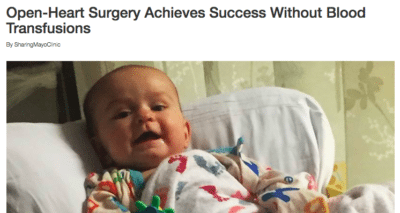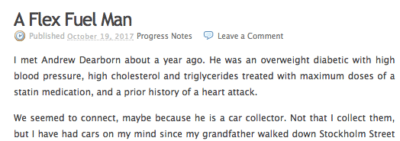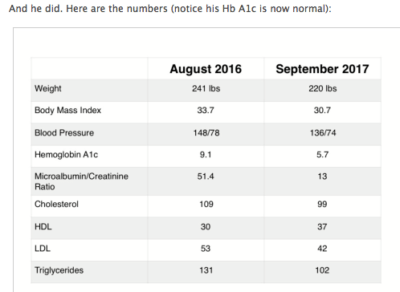 One of the easiest ways to attract new patients is to engage them with stories that inform them and build their trust in a medical practice. We refer to this as the “that’s like me!” motivational strategy. If a patient reads about how a doctor helped someone with a problem or pain similar to theirs, they’re more likely to think, “They can help me, too.”
One of the easiest ways to attract new patients is to engage them with stories that inform them and build their trust in a medical practice. We refer to this as the “that’s like me!” motivational strategy. If a patient reads about how a doctor helped someone with a problem or pain similar to theirs, they’re more likely to think, “They can help me, too.”
Mayo Clinic leads the pack when it comes to harnessing the power of patient stories. In fact, Mayo Clinic believes so strongly in the value of sharing patient stories that they have a dedicated webpage for them—Sharing Mayo Clinic. The page includes stories from patients, patients’ family and friends, and members of the Mayo Clinic staff.
No matter the severity of a patient’s condition, each story provides a platform for showcasing how Mayo Clinic helps patients with varying degrees of innovative, compassionate healthcare. It’s hard not to read through the stories and think, “That’s where I would want to be treated.” And this is precisely the effect you want your practice’s patient stories to have as well.
What the Mayo Clinic Knows About Stories, and How You Can Use Their Plan to Grow Your Practice
To get an idea of how simply sharing a scenario and solution can be incredibly informative and inspiring, take a look at these three patient stories from Mayo Clinic:

One of Mayo Clinic’s own cardiology nurses had a heart attack, and she used the experience to empathize with patients and encourage women to listen to their bodies. By sharing her story, she connects more deeply with other patients and hopes her story will help other women who might be in denial about heart attack symptoms.

An infant with a complex heart defect required surgery, but she could not receive blood transfusions or blood products due to her family’s religion. Sharing the story of how Mayo Clinic’s teamwork and careful planning allowed for a successful surgery shows how the doctors at Mayo Clinic are 1) respectful of patients’ restrictions and 2) innovative in coming up with life-saving solutions.

A 35-year-old mother of three had little hope after being diagnosed with advanced breast cancer that had spread to her bones. However, the doctor who leads Mayo Clinic’s Breast Cancer Research group designed a customized treatment plan that was nothing like what she feared she’d need to go through, and the young mother is now cancer free. This patient story again highlights how the doctors and staff at Mayo Clinic are innovative and resourceful and care deeply about connecting with their patients.
I could go on and on about how smart it is from a marketing standpoint for Mayo Clinic to use patient stories like these. But in case you’re thinking, “They’re great, but I’m no Mayo Clinic,” that’s ok, because you don’t need to be.
You just need to tell stories about the patients you treat, and how you’ve helped them has had an impact on their lives.
Don’t get stuck on if your patients will want their story told, you don’t have to use a picture or a full name—the power of the story isn’t who it is, but that it is someone your patients might relate to.
For Example:
“I didn’t think a vacation at the beach would ever happen again because of how I felt about how my legs looked. Dr. Smith’s treatments transformed by legs. I can’t wait to head to Florida this spring.”
That story doesn’t have more or less impact because we say “Jill Black” vs “Jill B.,” and you can also add in other pieces of information like “48, mother, beach lover” to make that story relatable.
Two Examples of Local Doctors with Great Patient Stories
Here are two more patient stories from independent family doctors who’ve used patient stories quite well, and you can too.

A Country Doctor has practiced small town medicine for thirty years, seeing three or four generations of many families. He writes about a man named Andrew who was an overweight diabetic with high blood pressure, high cholesterol, and had a prior history of a heart attack.
The doctor was able to connect with this patient over a shared interest in cars and used an analogy about what type of fuel his body needed to run more effectively. Andrew was finally able to grasp his situation and as a result he lost weight and lowered his cholesterol and blood pressure.
 Sharing this patient story showed how this doctor is excellent at listening and is able to speak in a patient’s terms to motivate them to make changes. He did have permission to use the patient’s full name, but the story would be just as powerful with a first name only.
Sharing this patient story showed how this doctor is excellent at listening and is able to speak in a patient’s terms to motivate them to make changes. He did have permission to use the patient’s full name, but the story would be just as powerful with a first name only.
Notice that he didn’t use the patient’s photo, but at the end of the blog post he did use an image of the patient’s chart (right) showing how his numbers have dropped. Now that’s persuasive.

A Common Sense Family Doctor writes about his own experience of turning 40 and being diagnosed with prediabetes and GERD. Writing about how he felt about these labels makes him relatable, which is an endearing quality for a doctor to have. He concluded the blog post with how his experience will change what language or health terms he’ll use when talking with his patients, which makes him even more relatable.
Patient Stories Tell Your Practice Story Better Than You Can
Your patient stories can span the range of your treatment and they don’t have to be complicated or prove that you’re close to finding the cure for cancer.
The stories need to show that you value your patients as fellow human beings, that you are good at what you do, and you’re finding ways to help them live more healthy lives so that the patient can get back to what they love and enjoy.
When you do that, there’s no telling how many prospective patients are out there thinking, “That’s where I want to be treated.”
We can help you tell patient stories that prospective patients will relate to so that you’re top of mind when it comes to their healthcare choice. Baker Labs specializes in helping medical practices grow with customized digital tools and strategies. Contact us for a free marketing assessment of your medical practice, or for a free SEO audit of your website.
[hs_action id=”930″]


